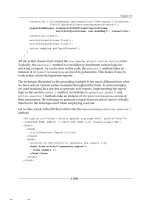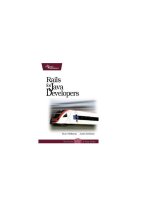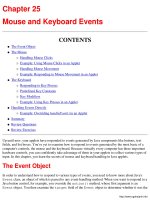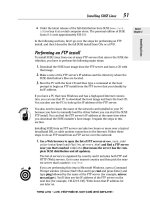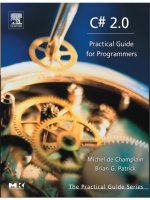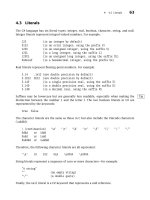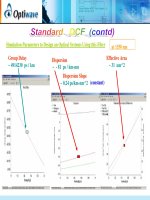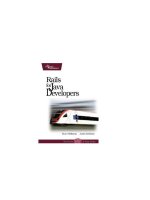Rails for Java Developers phần 2 pdf
Bạn đang xem bản rút gọn của tài liệu. Xem và tải ngay bản đầy đủ của tài liệu tại đây (192.26 KB, 30 trang )
RUNNING THE SAMPLES 31
It is possible to type longer blocks, such as this three-line if end block:
irb(main):002:0> if true
irb(main):003:1> puts "tautology"
irb(main):004:1> end
tautology
=> nil
If you make as many typing mistakes as we do, you can also paste
multiple l i nes of code into irb. When code starts to be l ong enough that
it is unwieldy to enter into irb, you will want to switch to full Ruby
programs.
Running Ruby Samples
All the Ruby samples for the book are from the rails_xt/samples direc-
tory, unless otherwise noted in the text. So, if you see the following
command:
$ ruby foo.rb
you can execute the same command wit hin the rails_xt/samples directory
after you unzip the sample code.
Running Rails Samples
The samples include a Rails application in the rails_xt directory. All Rails
commands should be run from this directory, unless otherwise noted.
When you see a command that begins with script, such as script/console
or script/server, run that command from the rails_xt direct ory.
The script/console command is particularly important. It gives you an
interactive Ruby shell with Rails and your application’s environment
already loaded. Try running script/ console from the rails_xt directory in
the sample code.
$ script/console
Loading development environment.
>> puts "Hello"
Hello
This is just like irb, except you can also now call Rails API methods. For
example, you could ask what database Rails is using:
>> ActiveRecord::Base.connection.current_database
=> "rails4java_development"
The default prompt in script/console is >>. When you see this prompt in
the book, you should be able to run the same code using script/console
in the rails_xt directory.
RAILS ENVIRONMENTS 32
Running the Unit Tests
We wrote much of the code in this book as exploration tests. Exploration exploration tests
tests are unit test s written for the purpose of learning, teachi ng, and
exploring. Sample code should be tested for the same reason people
unit test anything else: It is easy for us (and you!) to quickly verify that
the code w orks correctly.
You don’t need to run the unit tests to follow along in th e book (except
in the testing chapter!), and we typically do not clutter the prose by
including them. For example, here is the code from Section
4.8, Pre-
venting the N+1 Problem, on page 130, demonstrating a solution to the
N+1 problem in Hibernate:
Download code/hiberna t e_examples/src/TransactionTest.java
Criteria c = sess.createCriteria(Person.class)
.setFetchMode(
"quips"
, FetchMode.JOIN);
Set people =
new HashSet(c.list());
That’s the code you will see in the book, which demonstrates the point
being made. Notice that the listing begins with the filename. If you go
to that file in the sample code, you will find the code is followed imme-
diately by assertions th at prove the code works as intended:
assertEquals(2, people.size());
sess.close();
for (Iterator iterator = people.iterator(); iterator.hasNext();) {
Person p = (Person) iterator.next();
assertEquals(25, p.getQuips().size());
}
For more about exploration testing, also known as learning tests, see learning tests
“How I Learned Ruby”
11
and “Test Driven Learning.”
12
1.7 Rails En vironments
Web applications run in three distinct environments:
• In a development environment, there is a developer present. Code
and even data schemas tend to change rapidly and interactively.
Data is often crufted up by the developer, such as John Smith at
Foo Street.
11. http ://www.clarkware.com/cgi/blosxom/2005/03/18#RLT1
12. http ://weblogs.j ava.net/blog/davidrupp/archive/2005/03/test_dri ven_lea.html
RAILS ENVIRONMENTS 33
• In a test environment, automated tests run against prepackaged
sample data. A developer may or may not be present. Data sche-
mas are regularly trashed and rebuilt to guarantee a consistent
starting st ate for the tests.
• In a production environment, code and schemas change much
more rarely. The database data is real and valuable, and develop-
ers are rarely present.
In J ava web frameworks, environments have historically been ad hoc:
Each team evolves its own, using a collection of scripts and Ant tasks
to manage environments and move code and data between th em.
In Rails, environments are a first-class concept. Each application starts
life with the three environments in place. Rails envir onments are used
to select databases, log file destinations, policies for loading code, and
more. Here are some of Rails’ environmental defaults:
Development:
• The log file is log/development.log.
• The database is {appname}_development.
• The breakpoint server is enabled.
• Web pages show error stack traces.
• Classes reload for each page.
Test:
• The log file is log/test.log.
• The database is {appname}_test.
• The breakpoint server is disabled.
• Web pages show generic error messages.
• Classes load once at start-up.
Production:
• The log file is log/production.log.
• The database is {appname}_production.
• The breakpoint server is disabled.
• Web pages show generic error messages.
• Classes load once at start-up.
You can change environmental defaults by editing the appropriate envi-
ronment file. E nvironment files are named for the environment they
control, such as config/environments/development.rb for the development
environment. (You can even cr eat e new environments simply by adding
RAILS ENVIRONMENTS 34
files to the config/environments directory.) There is a top-level environ-
ment file named config/environment.rb that contains settings common to
all environments.
It is worth reading through the environment files to get a sense of the
automation that Rails provides. Here is a snippet:
Download code/people/config/environments/development.rb
# Log error messages when you accidentally call methods on nil.
config.whiny_nils = true
# Enable the breakpoint server that script/breakpointer connects to
config.breakpoint_server = true
# Show full error reports and disable caching
config.action_controller.consider_all_requests_local = true
config.action_controller.perform_caching = false
The most noticeable aspect is that the configuration is just Ruby. In a
Java web application, code is one language (Java), and configuration
is in another (XML). In Rails applications, Ruby is often used for both
code and configuration.
13
Let’s try modifying the Rails environment. Although Rails’ knowledge of
English grammar is pretty good, you might decide it is not good enough.
To experiment with Rails, you can run script/ console from any Rails
project, such as the People application at code/people in the sample
code.
$ script/console
Loading development environment.
>> "emphasis".pluralize
=> "emphases"
>> "focus".pluralize
=> "focus"
The Rails environment includes a pluralization rule smart enough for
emphasis but not for focus. We can add our own pluralization rules to
the environment. We’ll edit config/environment.rb (that way our rule will
be available in all environments):
Download code/people/config/environment.rb
Inflector.inflections do |inflect|
inflect.irregular
'focus'
,
'foci'
end
13. Other parts of Rails configuration use YAML (YAML Ain’t Markup Language), which is
intended to be easi er to read than XML. We cover YAML in Section 9.3, YAML and XML
Compared, on page
261.
HOW RAILS CONNECTS TO DATABASES 35
Now you should be able t o pluralize( ) your focus:
$ script/console
Loading development environment.
>> "focus".pluralize
=> "foci"
Rails support scripts and Rake tasks automatically select the envi-
ronment most likely to be righ t. For example, script/console defaults
to development, and rake test defaults to test. Many scripts report the
environment they are working in so you don’t forget:
$ script/console
Loading development environment.
It is easy to override the environment for a command. Simply prepend
RAILS_ENV=envname. For example, you might need to open a console
against a production server to troubleshoot a problem there:
$ RAILS_ENV=production script/console
Loading production environment.
1.8 How Rail s Connects to Database s
Rails programs access relational data through the ActiveRecord library
(see Chapter
4, Accessing Data with ActiveRecord, on page 96). U nder-
neath ActiveRecord, there is a driver layer. You will rarely call down into
the driver layer yourself, but you may need to configure the driver for
your application.
The database driver configuration is in the file config/database.yml. This
file is in YAML format.
14
The top-level names in database.yml are Rails
environments—by default, th ey are the three envir onment s discussed
in Section 1.7, Rails Environments, on page 32. Each top-level name
intr oduces a collection of indented, name/value pairs to configure the
driver f or a particular environment.
Rails chooses database names based on your application name plus
the environment n ame. For an application named Whizbang, the in i tial
config/database.yml would look like this:
development:
adapter: mysql
database: whizbang_development
# more driver settings
14. See Section 9.3, YAML and XML Compared, on page 261 for more about YAML.
RAILS SUPPOR T SCRIPTS 36
test:
adapter: mysql
database: whizbang_test
# more driver settings
production:
adapter: mysql
database: whizbang_production
# more driver settings
Don’t put anythi ng too
important in the test
database, since Rails
blows this database
away as part of running
unit and functional tests.
You can override the database names as you see fit by editing the con-
figuration file. One common override is to strip the _production part from
the production database name.
In this book, we are connecting to MySQL as the root user with no
password, because that is the exact setting that a new Rails application
generates by default.
1.9 Rails Sup port Scr i pts
Every new Rails application includes a script directory, with a set of
supporting Ruby scri pts. script is similar to the bin directory in many
Java projects. These scripts are run from the top directory of a Rails
project, like this:
stuthulhu:~/myproj stuart$ script/server
Do not navigate into the script directory and run scripts from there. Rel-
ative paths in Rails are always considered from the top pr oject direc-
tory, available within Rails as RAILS_ROOT.
You have already seen several scripts in this chapter: script/console,
script/server, and script/generate. All the scripts are summarized here:
script/about
Describes the Rails environment: Rails library versions,
RAILS_ROOT, and RAILS_ENV
script/breakpointer
Is an interacti ve Ruby shell that will take control of a Rails appli-
cation when a breakpoint statement is encountered
script/console
Is an interactive Ruby shell with access to your Rails app
script/destroy
Destroys code created by script/generate (be careful!)
RAILS SUPPOR T SCRIPTS 37
script/generate
Creates starter code from a template called a generator generator
script/performance/benchmarker
Runs a line of Ruby code n times and reports execution time
script/performance/profiler
Runs a line of Ruby code n times and reports relative time spent
in various methods
script/plugin
Installs and manages plugins ( third-party extensions)
script/runner
Runs a line of code in your application’s environment
script/server
Launches the web server and R ails application
You now know the basic structure of a Rails application, plus some of
the tools you can use to manage the development pr ocess. You will not
use all this information at once, though. Instead, use this ch apter as a
road map as you move through the book.
In the next chapter, we will take you on an extended tour of Ruby. Take
the time now to learn a bit of Ruby, and the rest of the book will be a
snap.
Chapter
2
Programmi ng Ruby
Ruby syntax looks pret ty foreign to a Java programmer. The mission
of this chapter is to explain Ruby syntax and the underlyin g concepts
this syntax supports. You will be happy to find that many of the under-
lying concepts are shared with Java: Ruby’s strings, objects, classes,
identity, exceptions, and access specifiers are easily mapped to their
corresponding numbers in the Java world.
2.1 Primitive Types
Java divides the world into primitive types and objects. The primitive
types represent numeric values of vari ous ranges and precision (some-
times interpreted in n on-numeric ways, for example as text characters
or true/false). Objects represent anythi ng t hey want to and are com-
posed of behaviors (methods) and state (other objects and/or primi-
tives). This section introduces the primitive types and their Ruby coun-
terparts.
Consider the Java primitive type int:
Download code/java_xt/src/TestPrimitives.java
public void testIntOverflow() {
int TWO_BILLION = 2000000000;
assertEquals(2, 1+1);
//Zoinks Not four billion!
assertEquals(-294967296 , TWO_BILLION + TWO_BILLION);
}
PRIMITIVE TYPES 39
Three factors are immediately evident in this simple example:
• Java variables are statically typed. On line 2, the keyword int indi-
cates that T WO_BILL ION must be an int. The compiler will enforce
this.
• Java takes advantage of a syntax we all know: infix math. To eval-
uate one plus one, you can say the obvious 1+1 (line 3), rather
than something annoying such as 1.plus(1).
• On line 5, two billion plus two billion does not equal four billion.
This is because Java’s primitives are confined to a specific number
of bits in memory, and four billion would need too many bits.
To represent arbitrarily l arge integers, Java uses the BigInteger class:
Download code/java_xt/src/TestPrimitives.java
public void testBigInteger() {
BigInteger twobil = new BigInteger(
"2000000000"
);
BigInteger doubled = twobil.multiply(
new BigInteger(
"2"
));
assertEquals(new BigInteger(
"4000000000"
), doubled);
}
In thi s example, BigInteger differs from int i n three ways:
• You cannot create a BigInteger instance with literal syntax. Instead
of BigInteger b = 10;, you say BigInteger b = new BigInteger("10") (line 2).
• You cannot use infix mathematical notation. On line 3, you have
to say a.multiply(b) instead of a*b.
• On line 4, two billion multiply two does equal four billion.
Ruby also knows how to manipulate integers. Like Java, Ruby needs to
do the following:
• Enforce type safety
• Provide a convenient syntax
• Deal smoothly with the human notion of integers (which is infinite)
inside a computer (which is finite)
Ruby takes a radically different appr oach to achieving these goals:
irb(main):010:0> 1+1
=> 2
irb(main):001:0> TWO_BILLION = 2
*
10
**
9
=> 2000000000
irb(main):002:0> TWO_BILLION + TWO_BILLION
=> 4000000000
• Everything in Ruby is an object, and types are usually not declared
in source code. So in stead of int TWO_BILLION= , you simply say
PRIMITIVE TYPES 40
TWO_BILLION= There is no compiler to make sure TWO_BILLION is
really an integer.
• Ruby allows infix math syntax (2+2) for in tegers and any other
types that want it.
• Two billion plus two billion does equal four billion, as expected.
Behind the scenes, Ruby deals with integers of unusual size by manag-
ing two different types: Fixnum for small integer s that have a convenient
representation and Bignum for larger numbers. It is possible to find out
which type is actually being used:
irb(main):016:0> 1.class
=> Fixnum
irb(main):017:0>
TWO_BILLION.class
=> Bignum
Most of the time you will not care, because Ruby transparently uses
the appropriate type as needed:
irb(main):004:0> x = 10
**
9
=> 1000000000
irb(main):005:0>
x.class
=> Fixnum
irb(main):006:0> x
*
= 100
=> 100000000000
irb(main):007:0>
x.class
=> Bignum
Notice t hat x smoothly shifts from Fixnum t o Bignum as necessary.
We could repeat the previous comparison for the other Java primitives,
but this would be a waste of space, because the underlying story would
be mostly the same as for i nt. Here are a few other factors to r emember
when dealing with numeric types in Ruby:
• Numeric types are always objects in Ruby, even wh en they have a
literal representation. The equivalents for methods such as Java’s
Float.isInfinite are instance methods on t he numerics. For example:
irb(main):018:0> 1.0.finite?
=> true
irb(main):019:0> (1.0/0.0).finite?
=> false
Note that the question mark at the end of finite? is part of the
method name. The trailing question mark has no special meaning
to Ruby, but by convention it is used for methods that return a
boolean.
STRINGS 41
• Like Java, Ruby will coerce numeric types in various reasonable
ways:
irb(main):024:0> (1 + 1).class
=> Fixnum
irb(main):025:0> (1 + 1.0).class
=> Float
If you try something unreasonable, you will know soon enough
because Ruby will throw an exception:
irb(main):027:0> (1.0/0)
=> Infinity
irb(main):028:0> (1/0)
ZeroDivisionError: divided by 0
For information about character types, see Section 2.2, Strings, below.
For booleans, see Section 2.5, Control Flow, on page 51.
2.2 Strings
In Java, strings are commonly represented as double-quoted literals.
The implementation of Java String is a class, with methods, fields, and
constructors.
However, because string concatenation is so fundamental to many pro-
gramming tasks, String also has some special abilities. The most impor-
tant of these is concatenation wit h the + sign:
Download code/java_xt/src/DemoStrings.java
String name =
"Reader"
;
print(
"Hello, "
+ name);
The Ruby syntax is similar:
irb(main):001:0> name = "Reader"
=> "Reader"
irb(main):002:0>
"Hello, " + name
=> "Hello, Reader"
Java Strings also have a format method, which uses sprintf-like format
specifiers:
print(String.format(
"Hello, %s"
, name.toUpperCase()));
Ruby of fers a different approach for formatting, using a literal syntax
called string interpolation. Inside a double-quoted string, text between string interpolation
#{ and } is evaluated as Ruby code.
STRINGS 42
This is similar to ${} property expansion in Java’s Ant. You could write
the preceding example with string int erpolation:
Download code/rails_xt/sample_output/interpolation.irb
irb(main):005:0> "Hello, #{name.upcase}"
=> "Hello, READER"
In Java, you can use backslash escapes to represent characters:
print(String.format(
"Hello, \"
%s\
"\nWelcome to Java"
, name));
Ruby also uses backslash escapes:
irb(main):008:0> puts "Hello, \"#{name}\"\nWelcome to Ruby"
Hello, "Reader"
Welcome to Ruby
In both the previous Ruby and Java examples, we escaped the double-
quote character inside th e string (\") to avoid terminating th e string.
This kind of escaping can be confusing to read if you escape a lot of
characters:
irb(main):009:0> puts "\"One\", \"two\", and \"three\" are all strings."
"One", "two", and "three" are all strings.
In Ruby, you can get rid of all these backslash escapes. You simply pick
an alternate string delimiter such as {} by prefixing a string with %Q:
Download code/rails_xt/sample_output/quoting.irb
irb(main):011:0> puts %Q{"One", "Two", and "Three" are strings"}
"One", "Two", and "Three" are strings"
In Java, individual characters are represented by single quotes. You
can pull individual characters from a string via the charAt method:
Download code/java_xt/src/TestStrings.java
public void testCharAt() {
assertEquals(
'H'
,
"Hello"
.charAt(0));
assertEquals(
'o'
,
"Hello"
.charAt(4));
}
}
Ruby handles individual characters differently. Character literals are
prefixed with a question mark:
irb(main):015:0> ?A
=> 65
irb(main):016:0>
?B
=> 66
STRINGS 43
Ruby also handles extraction differently. For example, you could call a
method named slice, but Ruby programmers would typically prefer to
use t he [ ] syntax instead:
irb(main):019:0> ?H == "Hello".slice(0)
=> true
irb(main):020:0>
?H == "Hello"[0]
=> true
The really cool part of using slice /[ ] is that it performs reasonable tasks
with all kinds of arguments. You can count from the back of a string
with negative offsets:
irb(main):022:0> ?o == "Hello"[-1]
=> true
You can take substrings by passing two arguments:
irb(main):025:0> "Hello"[1,4]
=> "ello"
Asking for a char act er past the end of a string returns ni l:
irb(main):026:0> "Hello"[1000]
=> nil
But, attempting to set a character past th e end of a string throws an
exception:
irb(main):009:0> "Hello"[1000] = ?Z
IndexError: index 1000 out of string
Although interpolation is useful, you will not want it in all cases. To
turn of f string interpolation, use a single-quoted string instead of a
double-quoted one:
irb(main):028:0> "Hello, #{name.upcase}"
=> "Hello, READER"
irb(main):029:0> 'Hello, #{name.upcase}'
=> "Hello, \#{name.upcase}"
In Java, you can create multiline strings by embedding \n characters:
print(
"one\ntwo\nthree"
);
The embedded backslashes are legal Ruby too, but there is an easier
way. Ruby provides an explicit syntax for multiline strings called a here
document, or heredoc. heredoc
A multiline strin g begins with <<, followed by a stri ng of your choice.
That same string appears again at the beginning of a line to termi nate
the heredoc:
OBJECTS AND METHODS 44
Download code/rails_xt/sample_output/heredoc.irb
irb(main):035:0> puts <<MY_DELIMITER
irb(main):036:0" one
irb(main):037:0" two
irb(main):038:0" three
irb(main):039:0" MY_DELIMITER
one
two
three
Regular expressions provide a powerful syntax for finding and modi-
fying ranges of characters within Stri ngs. For example, h ere is a Java
method that uses a regular expression to bleep out any four-letter
words that appear in a String:
Download code/java_xt/src/Bowdlerize.java
public static String bleep(String input) {
return input.replaceAll(
"\\b\\w{4}\\b"
,
"(bleep)"
);
}
}
Ruby uses a literal syntax for regular expressions, delimiting them with
//. As a result, a Ruby programmer might bleep like this:
Download code/rails_xt/sample_output/regexp.irb
irb(main):041:0> 'Are four letter words mean?'.gsub(/\b\w{4}\b/, "(bleep)")
=> "Are (bleep) letter words (bleep)?"
The gsub method replaces all matches of its first ar gument with its
second argument.
Notice that the regular expression itself looks slightly different in the
Ruby and Java versions. Where you see a single backslash in the Ruby
version, the Java version has a double backslash. The Java regular
expression is built from a Java strin g, and the paired backslashes
translate to single backslashes after the string is parsed. The Ruby
regular expression does not pass through a temporary “string phase,”
so the single backslashes are represented dir ect l y.
2.3 Objects and Methods
In this section, we will show how to use objects by calling their methods.
In Section 2.6, Defining Classes, on page 57, we will show how to define
your own classes of objects.
OBJECTS AND METHODS 45
You have already seen some examples of objects and methods in Sec-
tion 2.2, Strings, on page 41. Strings are just a kind (class) of object: A
method is code that is defined by an object to manipulate the object,
return a result value, or both. To invoke a method on a string, or any
other object, append a dot (.), the name of the method, and parenthe-
ses, as i n (). For example, to get the lowercased version of a string in
Java, you use t he following:
Download code/java_xt/src/DemoMethods.java
print(
"HELLO"
.toLowerCase());
Ruby is similar, except the parentheses are optional:
irb(main):047:0> "HELLO".downcase()
=> "hello"
irb(main):048:0> "HELLO".downcase
=> "hello"
Methods often have arguments: one or more pieces of additional infor-
mation that the object uses. For example, Java has a Math object, with
a cos method that takes a single argument, the ang l e in r adians:
Download code/java_xt/src/DemoMethods.java
print(Math.cos(0));
In this case, the Ruby version can match exactly, since Ruby also pro-
vides a Math object.
irb(main):051:0> Math.cos(0)
=> 1.0
In Ruby, you can omit the parentheses around arguments, if the syntax
is otherwi se unambiguous:
irb(main):051:0> Math.cos 0
=> 1.0
In Java, objects are type-safe. Objects know what they are capable of, type-safe
and you cannot ask them to perform methods they do not have. The
following code wil l fail in Java, since strings do not have a cos method:
Download code/java_xt/src/DemoMethods.java
print(
"hello"
.cos(0));
Ruby objects are also type-safe:
irb(main):057:0> "hello".cos 0
NoMethodError: undefined method ‘cos' for "hello":String
from (irb):57
OBJECTS AND METHODS 46
Type Safety Does Not Ensure Correctness
Type safety is a very weak assurance that your program actually
works as in tended. Type safety says that your pieces fit together,
not that you have chosen all the right pieces. Imagine your
car’s lubr ication system filled with orange juice. It is “type-safe”
in that the lubrication system contains the right “type” (a liquid),
but we wouldn’t recommend driving it.
Returning to our math exampl e, what if you thought Math.cos
expected degrees instead of radians?
irb(main):067:0> Math.cos 180
=> -0.598460069057858
There is nothing in the previous Ruby code, or its Java equiva-
lent, to tell that your result is radically different from what you
intended:
irb(main):069:0> Math.cos Math::PI
=> -1.0
In September 1999, a “little problem” similar to this one
destroyed the Mars Climate Orbi ter. A miscalculation based on
English instead of metric units caused the orbiter to pass too
close to Mars, where it was destroyed by the atmosphere.
One approach to these type-safety issues is to add even more
type safety. Instead of using primitive types, you could create
value types with embedded units in an enumeration. Without
first-class language support, this makes code more cumber-
some. A more likely approach in Ruby is to ha ve good auto-
mated tests.
Although both Ruby and Java are type-safe, they achieve type safety in
different ways. Ruby uses dynamic typing. Objects carry type informa-
tion with them, and that information is used at runtime to determine
the set of legal methods for the object. Java also provides static typing:
Variables have types that are enforced at compile time by the Java com-
piler. Both approaches have their merits, and the difference will crop
up several t i mes throughout this book.
We believe that type safety can never be perfect. No matter how rigor-
ously you enforce t yping, type errors can still occur. See the sidebar on
the current page for a few examples.
COLLECTIONS AND ITERATION 47
2.4 Collections and Iteration
Computer science is filled with all manner of esoteric collections (data
structures). Being general-purpose languages, Java and Ruby can han-
dle any of these, but daily use often boils down to three concerns:
• Ordered collections such as arrays accessed by numeric index
• Fast mappings from keys to values, also known as dictionaries or
hashes
• Iteration, the generic traversal of any collection or stream of data
The following sections cover these most common usages of collections
and iteration.
Arrays
Java deals with collections in two ways: arrays and collection classes.
Arrays are a language construct, and they hold a fixed-size collection of
some primitive type or object.
The collection classes work with objects, and they implement a wide
variety of different data structures. Here’s a simple example that loops
over the array of program arguments, prin ting them to the console:
Download code/java_xt/src/PrintAr gs.java
public class PrintArgs {
public static void main(String[] args) {
for (int n=0; n<args.length; n++) {
System.out.println(args[n]);
}
}
}
Here is the Ruby equivalent:
Download code/rails_xt/samples/print_args.rb
ARGV.each {|x| puts x}
Running the program produces the following:
$ ruby samples/print_args.rb one two three
one
two
three
Let’s start by talking about what isn’t in the Ruby version:
• The Ruby version does not have an equivalent to the Java PrintArgs
class. Ruby programs begin life with an implicit top-level object,
so simple programs do not need to define any classes at all.
COLLECTIONS AND ITERATION 48
• The Ruby version does not have a main method. Ruby executes
any code it encounters, so simple programs do not need to define
any methods either.
• Ruby’s puts is (roughly) equivalent to Java’s System.out.println. The
call to puts does n ot need an explicit object; it is invoked on the
implicit top-level object.
Now, back to th e one line of code. Here is the Ruby equivalent:
ARGV.each {|x| puts x}
Ruby populates ARGV as an array of command-line arguments. The rest
of the li ne does the following: “Take each element from ARGV, one at a
time. Assign it t o x. Then perfor m the block of code between the curly block
braces (and after the |x|).” If you want to spread a block over multi-
ple lines, you can use do end. Here’s the argument-printing program,
using do end:
Download code/rails_xt/samples/print_args_long.rb
ARGV.each do |x|
puts x
end
Ruby arrays have a literal syntax, so they can easily be created inline:
irb(main):009:0> ['C', 'Java', 'Ruby'].each {|lang| puts "#{lang} is fun!"}
C is fun!
Java is fun!
Ruby is fun!
=> ["C", "Java", "Ruby"]
If each item in the array is a word, there is an even shorter syntax, th e
%w shortcut:
irb(main):002:0> ['C', 'Java', 'Ruby'] == %w{C Java Ruby}
=> true
Ruby arrays respond in a reasonable way to mathematical operators:
Download code/rails_xt/sample_output/array_literals.irb
irb(main):002:0> [1,2] + [3]
=> [1, 2, 3]
irb(main):003:0> [1,2,3]
*
2
=> [1, 2, 3, 1, 2, 3]
irb(main):004:0> [1,2,1] - [2]
=> [1, 1]
irb(main):005:0>
[1,2] / 2
NoMethodError: undefined method ‘/' for [1, 2]:Array
from (irb):5
COLLECTIONS AND ITERATION 49
Ruby arrays are resizable and can use push and pop to act like stacks:
irb(main):006:0> skills = ['C', 'Java']
=> ["C", "Java"]
irb(main):007:0>
skills.push 'Ruby'
=> ["C", "Java", "Ruby"]
irb(main):008:0> skills.pop
=> "Ruby"
Java Map and Ruby Hash
Java has several implementations of Maps, which are collections that
manage key/value pairs. One such collection is the environment vari-
ables. Here, then, is a simple program that enumerates the environ-
ment var i ables:
Download code/java_xt/src/PrintEnv.java
import java.util.
*
;
public class PrintEnv {
public static void main(String[] args) {
Map map = System.getenv();
for (Iterator it = map.entrySet().iterator(); it.hasNext();) {
Map.Entry e = (Map.Entry) it.next();
System.out.println(String.format(
"%s: %s"
, e.getKey(), e.getValue()));
}
}
}
Here is the Ruby equivalent:
Download code/rails_xt/sample_output/hashes.irb
irb(main):032:0> ENV.each {|k,v| puts "#{k}: #{v}"}
TERM_PROGRAM: Apple_Terminal
TERM: xterm-color
SHELL: /bin/bash
ANT_HOME: /users/stuart/java/apache-ant-1.6.2
lots more
Ruby sets ENV to the environment var i ables. After that, iteration pr o-
ceeds with each. This time, the block takes two parameters: k (key) and
v (value). Blocks are a completely general mechanism and can take any
number of arguments. Functions that use blocks for iteration tend pass
one or two parameters to the block, as you have seen.
Most Ruby objects that manage key/value pairs are instances of Hash.
Like arrays, hashes have a literal syntax:
irb(main):037:0> dict = {:do => "a deer", :re => "a drop of golden sun"}
=> {:do=>"a deer", :re=>"a drop of golden sun"}
COLLECTIONS AND ITERATION 50
Curly braces introduce a hash. Keys and values are separated by =>,
and pairs are delimited by commas. You can get and set the values in
a hash with the methods fetch and store:
irb(main):013:0> dict.fetch(:do)
=> "a deer"
irb(main):014:0>
dict.store(:so, "a needle pulling thread")
=> "a needle pulling thread"
But Ruby programmers prefer to use the operators [ ] and [ ]=:
irb(main):015:0> dict[:so]
=> "a needle pulling thread"
irb(main):016:0> dict[:dos] = "a beer"
=> "a beer"
The [ ] and [ ]= operators are easy to remember, because they borrow
from mathematical notation. They are also more compact than the
named met hods fetch and store.
Better Th an For, and More Than Each
Java 5.0 introduced a more expressive syntax for iteration. The fol-
lowing example uses Java 5.0’s For-Each loop to enumerate first the
command-line arguments and then the environment variables:
Download code/java_xt/src/ForEach.java
import java.util.Map;
public class ForEach {
public static void main(String[] args) {
for (String arg: args) {
System.out.println(arg);
}
for (Map.Entry entry: System.getenv().entrySet()) {
System.out.println(
String.format(
"%s : %s"
, entry.getKey(), entry.getValue()));
}
}
}
This is nice! Notice that Java arrays and collections can now both be
handled with a parallel syntax.
Also, Ruby uses each and blocks to do much more than we have shown
here. For example, you can perform a transformation on each item in a
collection using collect:
irb(main):017:0> [1,2,3,4,5].collect {|x| x
**
2}
=> [1, 4, 9, 16, 25]
CONTROL FLOW 51
Or, you can find all the items that match some criterion by passing
find_all, a block that is interpreted as a boolean:
irb(main):021:0> [1,2,3,4,5].find_all {|x| x%2==0}
=> [2, 4]
We want to make two important points from these examples:
• Languages e volve and improve over time. Usually improvement
comes not from thin air but from ideas that have already been
explored elsewhere. Java’s For-Each syntax was inspir ed by other
languages that have similar features. The programmers who facil-
itate this kind of cr oss-pollination ar e those who become fluent i n
multiple programming languages.
• Languages evolve at many levels. Runtimes can change, language
syntax can change, and libraries can change. In Java, iteration
changes like the addition of For-Each are language changes. Sim-
ilar changes in Ruby are library changes, since each et. al. are
method calls. Library changes are easier to make than language
changes. (Many developers write libraries, few developers write
languages, and language evolution tends to be retarded by stan-
dards bodies, backward compatibility, and so on.) Merely pointing
out that Java and Ruby enable different approaches to change is
not a value judgment. However, it may lead to value judgments
in a specific context (which you must provide). What parts of your
system need to change? On what timeline, and under whose direc-
tion? Conversely, what parts need to st ay rock-solid stable and be
guaranteed to work in the same fashion across different projects
over time?
2.5 Control Flow
Ruby’s if and while are similar t o Java’s but have alternative forms that
are shorter in some circumstances. Instead of a for loop, Ruby uses
Range#each. Where Java has switch, Ruby provides a mor e general case.
Each is described in the following sections.
if
Java’s if statement, with optional else, allows programs to branch based
on the truth value of an expression:
CONTROL FLOW 52
Download code/java_xt/src/DemoControlFlow.java
if (n > 5) {
print(
"big"
);
}
else {
print(
"little"
);
}
Ruby also has an if statement . Instead of using curly braces to delimit
the optional code, Ruby uses newlines and end:
Download code/rails_xt/samples/control_flow.rb
if n>5
puts
"big"
else
puts
"little"
end
Everything in Ruby has a return value, so instead of putting the puts
inside both branches of the if statement, you can hoist it out:
puts(if (n>5)
"big"
else
"little"
end)
The if inside parentheses looks odd to us, and we wouldn’t usually code
Ruby this way. A more compact form exists. The ternary operator works
just as it does in Java:
puts n>5 ?
"big"
:
"little"
Java will not automatically coerce values to create booleans for a con-
ditional. To check whether an object exists, you cannot say this:
Download code/java_xt/src/DemoControlFlow.java
if (o) {
print(
"got o"
);
}
You must explicitly compare the object to null:
if (o != null) {
print(
"got o"
);
}
Ruby will automatically coerce values to booleans. The following code
produces false
Download code/rails_xt/samples/control_flow.rb
o = nil
puts o ? true : false
CONTROL FLOW 53
Only false/nil is false. Even zero coerces to true. The following code pro-
duces true.
o = 0
puts o ? true : false
Often, the body of a control statement is a single expression. Ruby can
pack mult i ple statements on one line separated by semicolons, so you
might be tempted to replace this:
if lines > 1
puts
"you have more than one line"
end
with the following:
if lines > 1; puts
"you have more than one line"
; end
Or maybe not—that’s a bit ugly. Fortunately, Ruby provides a short
form called a statement modifier. The following code is equivalent to the statement modifier
two preceding snippets:
puts
"you have more than one line"
if lines > 1
Sometimes you want to take action if a condition is not tr ue. As a con-
venience, you can use unl ess, wh i ch is the opposite of if. The f ollowing
statements are equivalent:
puts
"you've got lines"
if lines != 0
puts
"you've got lines"
unless lines == 0
while
Java’s while loop is like if, except it repeats as long as the condition
remains true. The following code prints the squares of numbers from
one to five:
int n=1;
while (n<=5) {
print(n
*
n);
n++;
}
Ruby also does while:
i=1
while (i<5)
puts i
*
i
i+=1
# no ++ in Ruby
end
The opposite of while is until, which repeats as long as a condition stays
false:
CONTROL FLOW 54
i=1
until (i>5)
puts i
*
i
i+=1
end
Like with if, you can use while and unless as stat ement modifiers. The
following program runs an input loop, shouting back everything passed
via stdin:
Download code/rails_xt/samples/short_while.rb
line =
""
puts
"Shouting back #{line.upcase}"
while line=gets
Ranges
Is it possible to use the statement modifier form of while to implement
our number-squaring example in a single lin e of code? Yes, but it isn’t
pretty:
irb(main):026:0> i=1; puts(i
*
i) || i+=1 while i<=5
1
4
9
16
25
The ugliness here comes from using the boolean operator || to shoehorn
two st atements into one to conform to the requirements of the state-
ment modifier form. We would not write code like this, and fortunately
you do not have to in Ruby. The preferred one-line implementation is
as follows:
Download code/rails_xt/sample_output/range.irb
irb(main):029:0> (1 5).each {|x| puts x
*
x}
1
4
9
16
25
The expression (1 5) is a literal for a Ruby type: the Range. Ranges make
it easy to represent repetitive data, such as “the numbers one through
five” in this example.
The call to each and the block syntax work exactly as they did for arrays
and hashes back in Section
2.4, Java Map and Ruby Hash, on page 49.
That is, the block is invoked once for each item in the range, with x
assigned to the value of th e item.
CONTROL FLOW 55
Ranges include their first element. The last element is included if you
use ( 1 10) but excluded if you add another dot, as in (1 10):
irb(main):014:0> (1 10).max
=> 10
irb(main):015:0> (1 10).max
=> 9
irb(main):016:0> (1 10).exclude_end?
=> false
irb(main):017:0> (1 10).exclude_end?
=> true
Ranges are not just for numbers:
("A" "C").each {|x| puts x
*
5}
AAAAA
BBBBB
CCCCC
You can conveniently step through Ranges, skipping some elements:
Download code/rails_xt/sample_output/range_step.irb
irb(main):003:0> ('A' 'I').step(2) {|x| print x}
ACEGI
case
Java provides a sw i tch statement that can branch to different actions
by testing equality with different values. Although y ou could imple-
ment the same logic using if, switch results in cleaner code if quite a few
branches are possible.
Here is an example that calculates a n umber grade from a letter grade:
Download code/java_xt/src/DemoSwitch.java
public static int numberGrade(char letter) {
switch(letter) {
case
'a'
:
return 100;
case
'b'
:
return 90;
case
'c'
:
return 80;
case
'd'
:
return 70;
case
'e'
:
case
'f'
:
return 0;
}
return 0;
}

